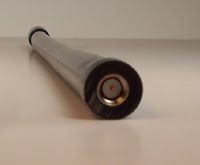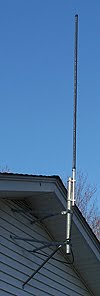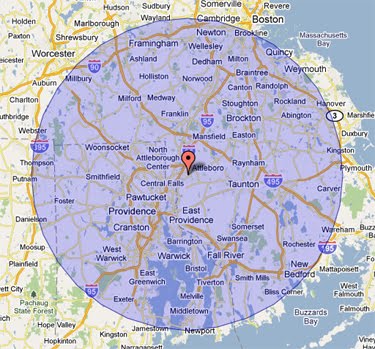If you have a scanner then you have an antenna, they don’t work well without them! Scanners will usually work better with better antennas. Makes sense, right?
So the next question is: What is the best antenna for me? The answer that age-old question is: “it depends”…
For many people using handheld scanners the antenna that came with it will often work just fine. If you are listening to local stuff then it probably is just fine. There are aftermarket antennas that will often work better for you, increasing the distance you can hear signals from or the strength of the signals you do hear. (Handheld Scanner Antennas)
All antennas are compromises. You have to balance size, construction and cost with the need for frequency range and portability. As a rule larger antennas usually work better than smaller ones, but that is not a golden rule.
Handheld scanners usually come with a “rubber ducky” style antenna. If you were to x-ray one or take it apart you will see that it is a coil of wire that looks like a spring, wrapped in rubber. This makes it flexible (so it doesn’t break) and allows more apparent length in a smaller package. These usually work pretty well for the most popular scanner bands (VHF-Hi and UHF) but not so good for VHF-Lo and 700-900 MHz.
You can buy a band-specific antenna, such as one made just for 800 MHz. While these will still work on other bands they will work best on the band they were designed for. If you use your scanner only for a specific band then consider an antenna for that frequency range for best performance.
If you use a scanner in the car or truck then some sort of outside or window antenna is almost always required. Remember that you are driving what is essentially a Faraday Cage, a metal cased vehicle that may also have metallic linings in the windshield. Unless you are listening to VERY local communications then you will likely need some sort of mobile antenna. These range from simple and inexpensive to complicated and expensive. (Mobile Scanner Antennas)
ScannerMaster makes several inexpensive and easy to install antennas for the car that will really work well for most casual scanner listeners. We have an antenna that looks like the cellular window mount antennas and another that mounts inside the windshield or back window. Another choice might be an outside magnetic mount antenna.
If you have a more professional need for a mobile antenna then we have several trunk-lip or hole mount antennas to choose from. These require installation by either a professional installer or someone who knows how to drill holes in a vehicle and route wires.
For reception in a home, office or other building the biggest advantage is elevation. The higher you go the better your reception in most cases. The best place for an antenna is the roof, preferably at the highest point. The next best is in an attic. Remember that any exterior antenna requires proper grounding and lightening protection! (Home/Office Scanner Antennas)
If you cannot install an antenna on the roof or in the attic then consider one of our inside antennas. These can be placed in a corner near an outside wall or window or even on a balcony. If you have a window air conditioner then maybe a magnet mount mobile antenna will work for you. Live in a high-rise? Try one of the inside mobile window mount antennas.
When buying a base station antenna to mount outside remember that some do not include coax and other necessities.(Antenna Coax) Remember that you need a place to mount it, like a TV antenna mast or vent pipe. Make sure you also account for the connectors, if your scanner has a BNC make sure you have the proper connector or adaptor. (Antenna Connectors)
In future Scanner Tips we will discuss antenna connectors, keep watching for that!

 By Jonathan Higgins
By Jonathan Higgins
 By Jonathan Higgins
By Jonathan Higgins When mounting an antenna outside make sure your clear of any power lines, and never install antenna by yourself. Try to find the best route for the coax cable, make sure you measure the route and only allow a little extra. Rule of thumb, higher the antenna the shorter the coax is always the best.
When mounting an antenna outside make sure your clear of any power lines, and never install antenna by yourself. Try to find the best route for the coax cable, make sure you measure the route and only allow a little extra. Rule of thumb, higher the antenna the shorter the coax is always the best. In Massachusetts and Rhode Island, most of the public safety is using VHF High Band or UHF. I was amazed by the reception. I was able to pick up UHF systems for 15 to 30 miles away without a problem, and as for the VHF, about 30+ miles away. In Massachusetts, the State Police are on an analog 800MHz trunking system. I was able to pick up the local site with ease and neighboring sites up to 20 miles away. I found that the height of the Ferret really brings in the VHF Low Band without a problem.
In Massachusetts and Rhode Island, most of the public safety is using VHF High Band or UHF. I was amazed by the reception. I was able to pick up UHF systems for 15 to 30 miles away without a problem, and as for the VHF, about 30+ miles away. In Massachusetts, the State Police are on an analog 800MHz trunking system. I was able to pick up the local site with ease and neighboring sites up to 20 miles away. I found that the height of the Ferret really brings in the VHF Low Band without a problem. Details about the Ferret…
Details about the Ferret…
 By Jonathan Higgins
By Jonathan Higgins